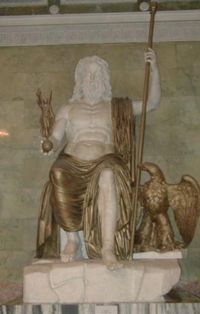Statue of Zeus at Olympia: Difference between revisions
imported>Richard Nevell No edit summary |
imported>Richard Nevell |
||
| Line 12: | Line 12: | ||
The temple was not intended to accommodate worshipers, but instead provide protection from weathering for religious paraphernalia. It is uncertain what this was to begin with, but it was replaced by a statue of Zeus. The sculptor Pheidias was commissioned to create the statue, and already had a reputation for work of outstanding quality. The Parthenon frieze may have counted among his works. The statue of Zeus was created by fixing [[ivory]] and gold to a wooden frame.<ref>Price, "The Statue of Zeus at Olympia", pp 62–63.</ref> | The temple was not intended to accommodate worshipers, but instead provide protection from weathering for religious paraphernalia. It is uncertain what this was to begin with, but it was replaced by a statue of Zeus. The sculptor Pheidias was commissioned to create the statue, and already had a reputation for work of outstanding quality. The Parthenon frieze may have counted among his works. The statue of Zeus was created by fixing [[ivory]] and gold to a wooden frame.<ref>Price, "The Statue of Zeus at Olympia", pp 62–63.</ref> | ||
According to [[Suetonius]]' biography of the Roman Emperor [[Caligula]], who reigned between A.D. 37 and A.D.41, Caligula gave orders for the Statue of Zeus at Olympia to be transported to Rome. However while the Romans were preparing to move the statue it laughed, scaring the workers away.<ref>Price, "The Statue of Zeus at Olympia", | According to [[Suetonius]]' biography of the Roman Emperor [[Caligula]], who reigned between A.D. 37 and A.D. 41, Caligula gave orders for the Statue of Zeus at Olympia to be transported to Rome. However while the Romans were preparing to move the statue it laughed, scaring the workers away. In 391, paganism was outlawed in the [[Roman Empire]], and the temple complex at Olympia fell out of use. The statue of Zeus was transported to [[Constantinople]] where it was displayed in a palace. However, the palace was consumed by fire in 462 and the statue was destroyed.<ref>Price, "The Statue of Zeus at Olympia", pp 76–77.</ref> | ||
==References== | ==References== | ||
{{reflist}} | {{reflist}} | ||
Revision as of 15:45, 2 August 2013
The Statue of Zeus at Olympia was built in the 5th century B.C. by Pheidias and was considered one of the Seven Wonders of the World.[1] Olympia was a centre for the worship of Zeus, and the statue renowned for its quality. It was destroyed in a fire in A.D. 462.
History
Olympia in the south of Greece was a sacred site to the ancient Greeks. It was a sanctuary of Zeus, king of the the Greek pantheon of gods and the site of the Olympic Games, which honoured Zeus. According to tradition the games began in 776 B.C., yet archaeologists have demonstrated there was ritual activity at Olympia pre-dating this, and over the centuries various buildings providing for pilgrims and religious activities were built. One such structure was the Temple of Zeus constructed between 466 B.C. and 456 B.C. (it would have looked something like the Parthenon which still stands in Athens).[2]
The temple was not intended to accommodate worshipers, but instead provide protection from weathering for religious paraphernalia. It is uncertain what this was to begin with, but it was replaced by a statue of Zeus. The sculptor Pheidias was commissioned to create the statue, and already had a reputation for work of outstanding quality. The Parthenon frieze may have counted among his works. The statue of Zeus was created by fixing ivory and gold to a wooden frame.[3]
According to Suetonius' biography of the Roman Emperor Caligula, who reigned between A.D. 37 and A.D. 41, Caligula gave orders for the Statue of Zeus at Olympia to be transported to Rome. However while the Romans were preparing to move the statue it laughed, scaring the workers away. In 391, paganism was outlawed in the Roman Empire, and the temple complex at Olympia fell out of use. The statue of Zeus was transported to Constantinople where it was displayed in a palace. However, the palace was consumed by fire in 462 and the statue was destroyed.[4]
References
- ↑ Price, Martin J. (1988). "The Statue of Zeus at Olympia", in Peter A. Clayton and Martin J. Price (eds.) The Seven Wonders of the Ancient World. Routledge. p 62.
- ↑ Price, "The Statue of Zeus at Olympia", pp 59–61.
- ↑ Price, "The Statue of Zeus at Olympia", pp 62–63.
- ↑ Price, "The Statue of Zeus at Olympia", pp 76–77.
